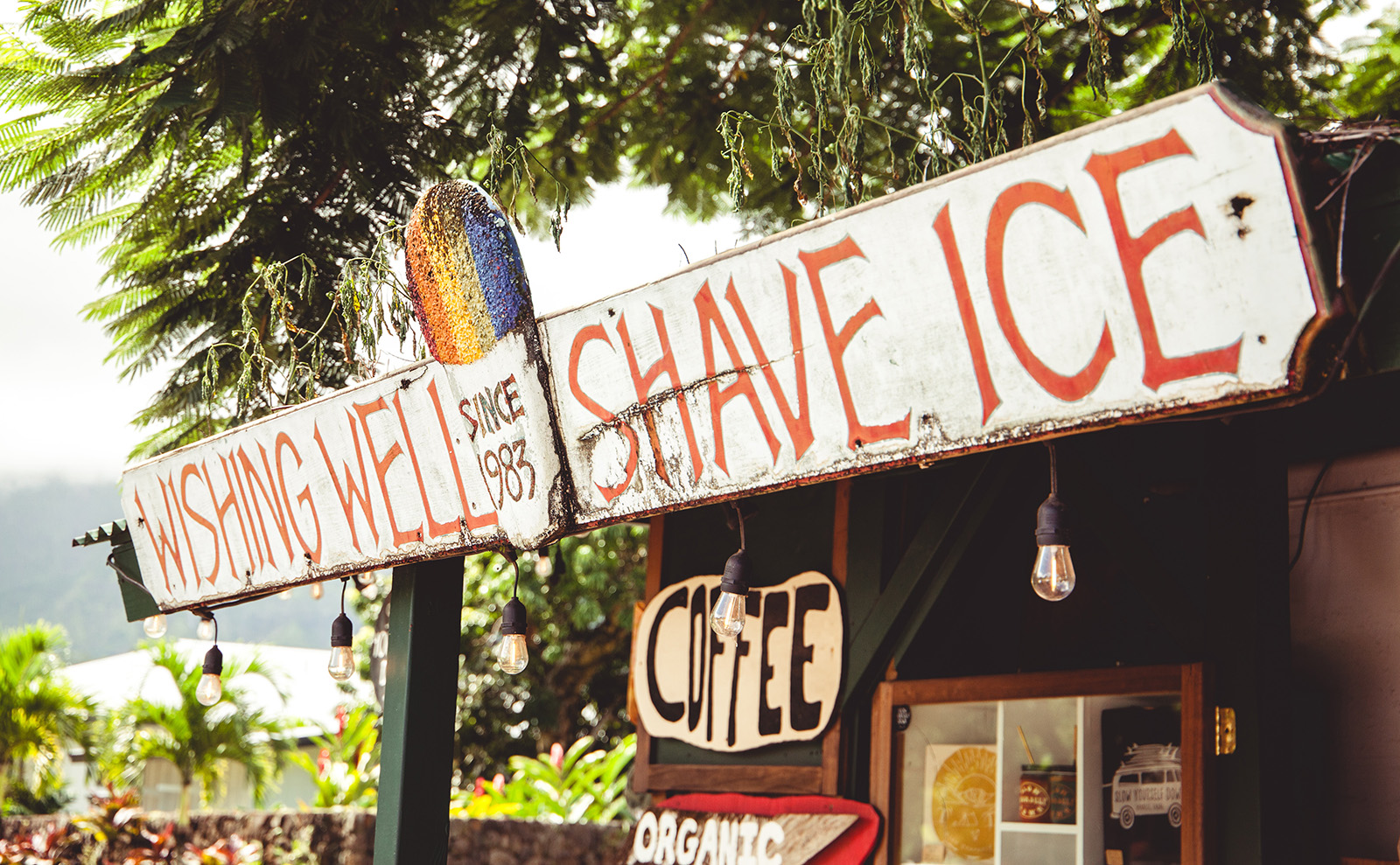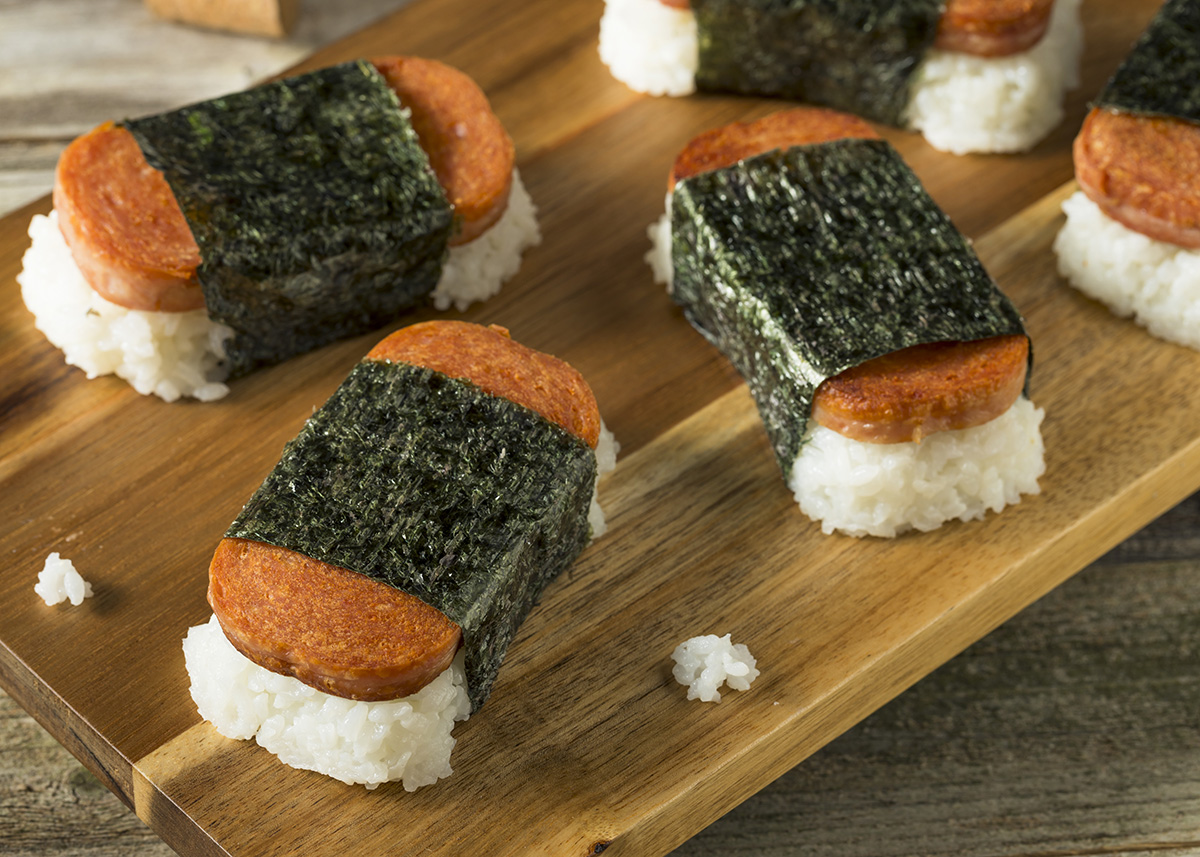
Armchair travel around the world!
Start your reading adventures with our FREE Reading Atlas.

- Around the World in 14 Books
- 7 Thrilling Book Series
- 6 Audiobooks That Are Like Theater For Your Ears



Food and drinks are some of the easiest ways — and the most fun— to vicariously experience another culture. When you add a great book to the mix, you've got the makings of a perfect evening. In Food+Fiction, we recommend a delicious read and a related recipe so you can try the taste of different destinations in your own kitchen.
This post is part of our Food+Fiction series.

Hawaiian food is a fusion of traditional Polynesian dishes and the influence of China, Japan, Korea, the Philippines, Puerto Rico, Portugal, and the US mainland.
That means delicious, local raw materials like fish, taro, coconut, pork, and pineapple are spiced up with other tropical and Asian flavors, plus good ol’ American junk food.
Which brings us to Spam musubi. It’s like the history of Hawaii transformed into an outrageously tasty, eminently portable snack.
Based on Japanese onigiri — rice balls wrapped in seaweed — Spam musubi is a slab of all-American Spam, nicely browned and bathed in sweet-salty teriyaki sauce. It’s then perched atop a thick bed of soft white rice and wrapped in a crisp sheet of nori. Taking a bite is like getting slapped in the face by an ocean wave at a barbecue, and it’s luscious.
In Hawaii, you see Spam musubi everywhere: in surfers’ hands at the beach, in school cafeterias and convenience stores and cafés. No picnic, potluck, or bake sale is complete without some — and you can eat it at any meal of the day or in between.
In the outrageous and/but thoroughly entertaining techno-thriller Micro, Lieutenant Dan Watanabe, a detective trying to get to the bottom of a confounding murder case, pops into a café for musubi because he ‘believed that Spam was a brain food.’
There’s no hard evidence that Spam musubi will make you smarter, but it is the ideal accompaniment to Micro. Both the snack and the story are over-the-top and multi-layered. They reward an adventurous spirit and are the best kind of junk food.
Most food historians seem to agree that Barbara Fuamara, a Japanese-American woman, invented this marriage of Spam and rice in 1983. She owned the Joni-Hana restaurant on Kauai and initially made the rice balls in a free-form, triangle shape. But an employee suggested a rectangular mold, and soon, Spam musubi was a sensation.
This charming video explores the key difference between musubi and sushi, the history of Spam musubi, and why it’s so irresistible.
When you’re ready to make Spam musubi at home — as lots of Hawaiians do — you can buy a special Spam slicer and fancy molds or a no-frills mold, specifically for making Spam musubi.
For optimal fun (and very satisfying Spam-shaped stacks), why not use the Spam can? After removing the Spam, wash and dry the can, then line it with a large piece of plastic wrap — the plastic wrap should hang over the edges of the can by a few inches. Instant Spam musubi mold!
The recipe below is super-easy and produces the salty-sweet-crispy-chewy Spam musubi of which Hawaiian snack dreams are made.

Makes 8
Cook the rice. Place the rice in a fine mesh colander and rinse it with running cold water until the water runs clear. Drain excess water from the rice and transfer it to a saucepan. Add the 3 cups of water and bring to a boil. Reduce heat to low, cover, and simmer until the water has been absorbed, about 20 minutes. Remove the rice from the heat and dump it into a large bowl, fluffing it gently with a fork or rice paddle. Let it be until it’s cool enough to handle.
Prep the sauce. Place the sesame oil in a small saucepan and add the garlic. Warm over medium-low heat until the garlic is fragrant, then add the soy sauce, mirin, and brown sugar, stirring until the sugar is dissolved, about 5 minutes. Remove from the heat and set aside.
Fry the Spam. Cut the Spam into 8 even slices, lengthwise; they’ll be about 1/4-inch thick. Warm a large, non-stick skillet over medium heat. Place the Spam in the pan and cook 4-5 minutes until lightly browned, then flip and brown the other side. Pour the sauce into the pan; move and flip the Spam slices around to coat them with the sauce. Cook until they’re caramelized to your liking, then remove from the heat and set aside.
Prep the nori. Cut each nori sheet into thirds.
Assemble! Scoop about 3 tablespoons of rice into the plastic-lined Spam can. Use a spoon to gently even out the rice, then top with a slice of glazed Spam. Gather the corners of the plastic wrap and lift the rice-Spam stack out of the can. Place the nori slice over the Spam cross-wise, then wrap it around the edges, tucking the loose ends underneath. Repeat until they’re all compiled and either eat immediately or wrap in plastic wrap and store in the fridge. They taste best at room temp.
Extras! You can fancy up your Spam musubi by adding thin slices of egg omelet, pineapple, or avocado on top of the Spam before wrapping with nori — or sprinkle the rice with Japanese furikake, a nutty, salty, savory seasoning) before placing the Spam on top. You can buy the seasoning or use this super-simple recipe to make it yourself. If you like things spicy, you might also add a little mayo mixed with sriracha sauce.
Lieutenant Dan Watanabe sat at a table in an eatery in downtown Honolulu, called the Deluxe Plate, holding a piece of Spam sushi in his fingertips. The sushi was a ball of fried rice wrapped in seaweed, with a chunk of Spam at the center. He took a bite. The seaweed, the fried rice, and the salty pork combined in his mouth into a taste that could be found nowhere but Hawaii. He savored it, chewing slowly. During World War II, whole shiploads of Spam had arrived in Hawaii to feed the troops. American soldiers had basically fought the war on Spam; Spam and an atomic bomb had guaranteed American victory. At the same time, the people of Hawaii had developed a passion for the canned pork product, a love that would never die. Dan Watanabe believed that Spam was a brain food. He believed it could help him think more clearly about a case. — Michael Crichton
Welcome to Nanigen MicroTechnologies, a mysterious biotech company on the Hawaiian island of Oahu. At the helm is a billionaire named Vin Drake. He possesses the dual gifts of charm and dubious ethics — and he uses both to lure a group of talented graduate students to the island with the promise of lucrative jobs. But on their visit to corporate headquarters, they see and hear things they shouldn’t. Before you can say, honey, I shrunk the kids, the students have fallen victim to Drake’s powerful shrinking technology. A mere half-inch tall, they’re dumped into the rain forest by the evil overlord, their deaths all but a certainty. Except these pesky kids keep finding ways to survive. {more}
This techno-thriller (448 pages) was published in November of 2011 by Harper. The book takes you to the island of Oahu in Hawaii. Melissa read Micro and loved it; it wouldn't be on our site if she didn't recommend it.
Bookshop.org is an online bookstore with a mission to financially support independent bookstores and give back to the book community.
Top image courtesy of Dustin Belt/Unsplash.
Want to keep up with our book-related adventures? Sign up for our newsletter!
Can you help us? If you like this article, share it your friends!
Strong Sense of Place is a website and podcast dedicated to literary travel and books we love. Reading good books increases empathy. Empathy is good for all of us and the amazing world we inhabit.
Strong Sense of Place is a listener-supported podcast. If you like the work we do, you can help make it happen by joining our Patreon! That'll unlock bonus content for you, too — including Mel's secret book reviews and Dave's behind-the-scenes notes for the latest Two Truths and a Lie.
Join our Substack to get our FREE newsletter with podcast updates and behind-the-scenes info — and join in fun chats about books and travel with other lovely readers.

We'll share enough detail to help you decide if a book is for you, but we'll never ruin plot twists or give away the ending.
Content on this site is ©2025 by Smudge Publishing, unless otherwise noted. Peace be with you, person who reads the small type.